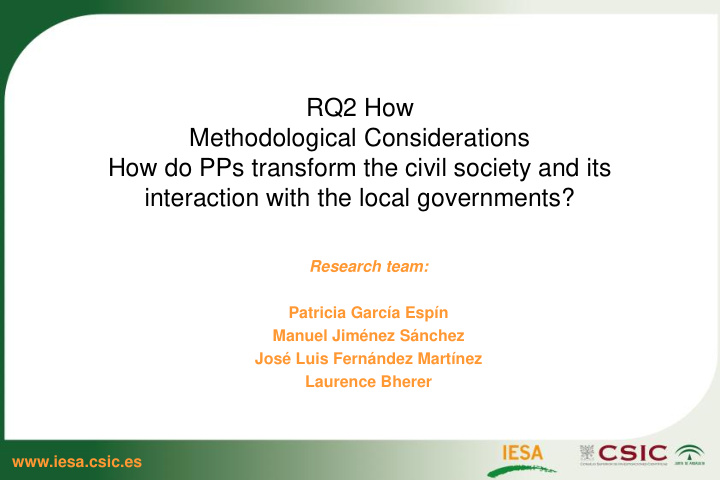



RQ2 How Methodological Considerations How do PPs transform the civil society and its interaction with the local governments? Research team: Patricia García Espín Manuel Jiménez Sánchez José Luis Fernández Martínez Laurence Bherer www.iesa.csic.es
1. Literature Review • Cases in Brazil, Britain, USA… • Focus on most influential, best practices or exemplar cases (Fung 2009) • The impacts of similar institutional devices (e.g. participatory budgeting: Sintomer and Ganuza 2011; Blanco and Ballester 2011; Baiocchi et al. 2011; Ganuza, Nez and Morales, 2014) • Effect production/context production: almost no studies considering various types of participatory devices and their effect production in comparative terms • Operationalization of changes (from local configurations to micro- processes of transformation). www.iesa.csic.es
2. Exploratory Fieldwork • Interviews with 8 scholars/ nationally recognized specialists • 2 nominal groups with public participation professionals (facilitators, organizers, public servants, etc.) Case selection • Useful for Case construction (informants) Operationalization (codebook) Hypothesis-building Fieldwork: Interview Guide www.iesa.csic.es
( Manuel Jiménez & Patricia García Espín. Participatory Processes as Democracy Enhancers. What effects, what mechanisms, what evidences in civil society and its interaction with the state . Forthcoming) Internally in civil society actors EFFECTS ON CIVIL SOCIETY (empowerment, & INTERACTION WITH AUTHORITIES resources, etc.) Between civil society actors (relationships) Between Local Authorities & Civil Society Civil Soc. Actors & Citizens Actors www.iesa.csic.es
4. Methods & Data Selection of Cases and Context • Typical or normal cases (as opposed to exemplar ones) • A variety of participatory devices • MECPALO Database • Purposive selection: Intensity of cases: Pre-check: - Durable in time & interactions (permanent) - Deliberative settings (interaction) - Influence in policy-making (proposals) - Homologous context (mid-size/post-industrial) - 3 regions 3 Advisory Councils 3 Participatory Budgeting www.iesa.csic.es
www.iesa.csic.es
4. Methods & Data Data • Desk: internal rules, minutes, marketing brochures, local media, etc. • 52 semi-structured interviews with informants (privileged observers) Observer Rep. Participant Policy Authority Association Policy Authority in Representative Non- Other Department Participant Association Case New Association- Opposition Participant Representative Public Public Participation Official/Different professional Department www.iesa.csic.es
4. Methods & Data Analysis: Transcription interviews CODING (Nvivo) Reliability Test 6 CASES CCA (CROSS-CASE (reconstruction) ANALYSIS) www.iesa.csic.es
Analyzing the effects E: Did it produce any change in the working style of social groups? I: Very limited, very limited … because we did not have time enough to break all the walls, the barriers. Thus, at the begining, you start trying to overcome (“tú vas sorteando”) those difficulties, and I think we did not have time enough. But I insist on the potentiallity …” (Participation proffesional, facilitator, participatory budgeting case, Andalucía, woman) www.iesa.csic.es
Thanks! Manuel Jiménez Sánchez Patricia García Espín José Luis Fernández Martínez Laurence Bherer https://cherrypickingproject.wordpre ss.com / www.iesa.csic.es
Recommend
More recommend